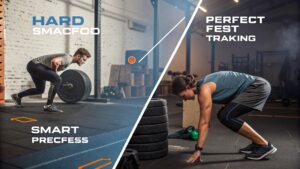Introduction
Sweat Smarter, Not Harder: The Ultimate Guide to Efficient and Sustainable Fitness
For decades, the fitness mantra has been “no pain, no gain.” We’ve been conditioned to believe that the only worthwhile workout is one that leaves us drenched, exhausted, and sore for days. But what if this all-out approach is actually holding you back? The new paradigm in health and performance isn’t about grinding harder; it’s about training with intention and intelligence. Learning how to Sweat Smarter, Not Harder is the key to unlocking sustainable progress, preventing injury, and achieving your fitness goals more efficiently than ever before. It’s a shift from brute force to strategic effort, focusing on quality over sheer quantity.
What Does “Sweat Smarter, Not Harder” Actually Mean?
The core philosophy of Sweat Smarter, Not Harder is about optimizing your input to maximize your output. It’s the antithesis of mindlessly going through the motions or pushing yourself to the point of breakdown every single session. This approach is rooted in exercise science and bioenergetics—the study of how energy is transformed in your body. A smart workout considers factors like energy systems (aerobic vs. anaerobic), specific muscle activation, recovery needs, and your individual goals. It means understanding that a 45-minute session with perfect form, focused intensity, and strategic exercise selection will almost always yield better results than a two-hour marathon of half-hearted, poorly executed movements.
For example, consider High-Intensity Interval Training (HIIT). A “hard” approach might be to perform burpees as fast as possible for 20 minutes, sacrificing form and risking injury. The “smarter” approach is to design a HIIT circuit with 30 seconds of all-out effort on a stationary bike (where form is less of an issue) followed by 90 seconds of active rest, repeated for 15-20 minutes. This smarter method allows for higher power output during the work intervals, better technique, and a more potent metabolic response, all while being safer and more time-efficient. It’s about working with your body’s physiology, not against it.
The Science Behind Intelligent Training: Why It Works
Understanding Energy Systems and Recovery
Your body has three primary energy systems: the phosphagen system for short, explosive bursts (think a 100m sprint), the glycolytic system for medium-duration efforts (like a 400m run), and the oxidative system for long-endurance activities (a marathon). Smart training involves targeting the specific system that aligns with your goals. If you want to build raw power, endlessly jogging for miles is an inefficient, “hard” way to do it. A smarter method would be short, heavy sled pushes or heavy weightlifting sets with ample rest, which precisely targets the phosphagen system. Furthermore, progress isn’t made during the workout itself; it’s made during the recovery period that follows. Constantly working at 100% intensity doesn’t allow for supercompensation—the process where your body repairs and strengthens itself beyond its previous level. Smart training strategically incorporates rest and lower-intensity days to facilitate this crucial process.
The Role of Mind-Muscle Connection and Form
A landmark study published in the European Journal of Sport Science highlighted that intentional, focused concentration on the muscle being worked—known as the mind-muscle connection—can significantly increase muscle activation compared to just moving weight. This is a cornerstone of sweating smarter. For instance, during a lat pulldown, a “hard” approach might involve using momentum to pull the heaviest weight possible, engaging the shoulders and biceps more than the back. The smarter approach is to use a manageable weight, initiate the movement by pulling your shoulder blades down and back, and consciously feel your lats do the work. This not only leads to better muscle growth but also drastically reduces the risk of joint and tendon injuries caused by poor, ego-driven form. Quality of repetition will always trump quantity.
Actionable Strategies to Implement Smart Training Today

1. Prioritize Compound Movements and Progressive Overload
The smartest way to spend your time in the gym is on compound exercises that work multiple muscle groups simultaneously. Movements like squats, deadlifts, push-ups, rows, and overhead presses deliver a superior return on investment for building strength and muscle and elevating your heart rate compared to isolation exercises like bicep curls. The key to smart progression is the principle of progressive overload—gradually increasing the stress on your musculoskeletal system over time. This doesn’t always mean adding more weight. You can get smarter by increasing reps, adding sets, improving your range of motion, or decreasing rest time. Tracking your workouts in a notes app or journal is non-negotiable for applying this principle effectively.
2. Embrace Periodization and Listen to Your Body
Periodization is the practice of systematically planning your training to peak for specific goals while managing fatigue. Instead of doing the same workout at the same intensity week after week (a fast track to plateauing), a smart plan varies the volume and intensity. This could mean having heavier strength days, lighter technique days, and active recovery days within a single week or month. Furthermore, tuning into your body’s signals is critical. Feeling unusually fatigued, sore, or irritable? That might be a signal for a lighter day or a full rest day, not a reason to push through and risk overtraining. Smart trainers know that consistency over months and years beats a few weeks of intense effort followed by burnout or injury.
3. Fuel and Hydrate Strategically
Training smart extends beyond the gym floor. You cannot out-train a poor diet or dehydrated body. Smart fueling means consuming a balanced meal with carbohydrates and protein about 1-2 hours before a workout to top off energy stores. Post-workout, prioritize protein intake to aid muscle repair. Hydration is equally crucial; even a 2% loss of body weight in fluids can significantly impair performance and cognitive function. A practical tip is to monitor your urine color—aim for pale yellow. For workouts longer than 60 minutes, consider an electrolyte drink to replenish what is lost through sweat.
Smart vs. Hard: A Comparative Look at Scenarios

Let’s break down the tangible differences between a “hard” and a “smart” approach across several facets of fitness. The benefits of the smarter method are overwhelmingly clear, focusing on longevity, efficiency, and results.
| Scenario | “Harder” Approach | “Smarter” Approach | Key Benefit |
|---|---|---|---|
| Cardio | 60 minutes of steady-state jogging at the same pace, every day. | 20 minutes of HIIT intervals (e.g., 30s sprint/90s walk) or 30-45 minutes of varied-pace cycling. | Time Efficiency & Metabolic Boost: HIIT can produce similar or better cardiovascular gains in less time and create a larger “afterburn” effect (EPOC). |
| Strength Training | Lifting the maximum weight possible with shaky form, 7 days a week. | Lifting with controlled, perfect form, focusing on mind-muscle connection, 3-4 days a week with rest days. | Injury Prevention & Muscle Growth: Proper form ensures the target muscles are worked effectively and keeps joints safe. Rest is essential for growth. |
| Recovery | Ignoring soreness and pushing through every workout. | Incorporating active recovery (walking, yoga), prioritizing sleep (7-9 hours), and using foam rolling. | Enhanced Performance & Consistency: Proper recovery reduces injury risk, allows muscles to rebuild stronger, and ensures you can perform well in your next session. |
| Goal Setting | “I want to lose 20 lbs in a month.” | “I will aim to lose 1-2 lbs per week by strength training 3x/week and adding 10k daily steps.” | Sustainability & Psychology: Realistic, process-based goals create sustainable habits and prevent the discouragement that comes with unrealistic expectations. |
Your Step-by-Step Guide to Building a Smarter Workout Plan

Building a smarter regimen doesn’t have to be complicated. Follow this simple framework to get started.
Step 1: Define Your Primary Goal. Be specific. Is it fat loss, building muscle, running a 5K, or increasing strength? Your goal dictates everything else.
Step 2: Select Your Exercises. Base your workouts around 2-3 compound movements per session (e.g., Squat, Bench Press, Bent-Over Row). Then, add 1-2 accessory or isolation exercises to target weak points or specific muscles (e.g., leg curls, lateral raises).
Step 3: Determine Your Sets, Reps, and Rest. For strength (goal: lift heavier), aim for 3-5 sets of 3-6 reps with 2-3 minutes of rest. For hypertrophy (goal: build muscle), aim for 3-4 sets of 8-12 reps with 60-90 seconds of rest. For endurance, aim for 2-3 sets of 15-20+ reps with 30-60 seconds of rest.
Step 4: Schedule Your Week with Recovery in Mind. A great smart split is a 3-day full-body routine or a 4-day upper/lower split. This ensures each muscle group is trained effectively but has 48-72 hours to recover before being stressed again. Never train the same muscle group on consecutive days.
Step 5: Track and Adapt. Use a notebook or app to record your weights, reps, and how you felt. Every 1-2 weeks, aim to progress in some small way. If you feel run down, don’t be afraid to swap a heavy day for a mobility or light cardio day.
Debunking Myths and Building Lifelong Habits
A major barrier to smart training is the pervasive myth that you must be exhausted to have done something worthwhile. This is simply not true. The quality of your effort is what matters most. Another myth is that more time always equals better results. In reality, after about 60-75 minutes of intense training, cortisol (a stress hormone) levels rise significantly, which can impede recovery and muscle growth. A focused 45-minute session is often far more productive.
Ultimately, the goal of adopting a Sweat Smarter, Not Harder mentality is to build a positive, sustainable relationship with fitness that lasts a lifetime. It’s about moving your body in a way that feels good, yields visible results, and protects you from the burnout and injuries that derail so many well-intentioned people. It empowers you to be the architect of your own health, using knowledge and strategy as your primary tools.
Ready to transform your fitness journey? Start by applying just one smart principle to your next workout. Focus on your form, prioritize your recovery sleep, or try a HIIT session. Share your experiences or questions in the comments below—let’s build a community of smart sweaters! For more in-depth guidance, check out our article on [The Ultimate Guide to Post-Workout Recovery].



